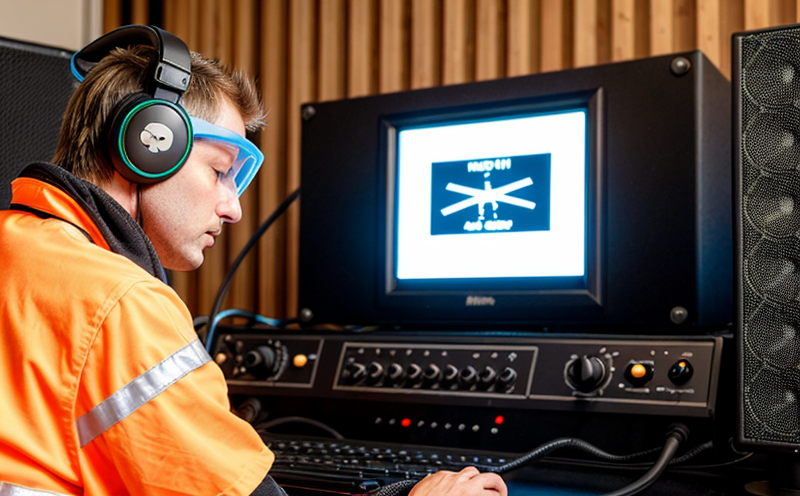ISO 8124-1 Musical Toy Acoustic Safety Testing
The ISO 8124 series of standards provides a comprehensive framework for the safety testing of toys, with Part 1: Mechanical and Physical Aspects focusing specifically on ensuring that musical toys do not pose any mechanical or physical hazards. This standard is crucial in protecting young children from potential injuries caused by sharp edges, small parts, and other hazardous components.
The testing procedure described in ISO 8124-1 involves a series of detailed experiments designed to assess the acoustic properties of musical toys. The primary objective is to ensure that these toys meet strict safety thresholds for sound levels and noise emissions, preventing ear damage or discomfort among users.
The testing process includes several key stages:
- Initial Setup: The specimen (the musical toy) is prepared in a controlled environment ensuring all parts are accessible for thorough examination.
- Noise Measurement: Using calibrated sound level meters, the emitted noise from the toy during normal operation is measured. This measurement helps to determine if the noise levels exceed safe thresholds as defined by the standard.
- Evaluation: The data collected during the noise measurements are compared against the permissible limits specified in ISO 8124-1. If any part of the toy emits sound above these limits, it fails the test and requires adjustments or redesign.
The importance of this testing cannot be overstated, especially considering that musical toys are frequently used by young children who may not fully understand the risks associated with loud noises. By adhering to ISO 8124-1, manufacturers can ensure their products meet international safety standards, thereby protecting users from potential harm.
In real-world applications, this testing is critical in industries ranging from toy manufacturing to retail, ensuring that consumer goods are safe for use and sale. For quality managers, compliance officers, R&D engineers, and procurement personnel involved in the toy industry, understanding ISO 8124-1 ensures they can make informed decisions regarding product safety.
Applied Standards
The primary standard for this service is ISO 8124-1: Mechanical and Physical Aspects of Toys - Part 1. This standard provides clear guidelines on the types of tests required to ensure musical toys are safe from a mechanical and physical hazard perspective. The ISO series includes other standards that, while not directly related to acoustic safety, support broader toy safety testing.
Other relevant international standards include:
- ISO 14730-2: Acoustics - Sound Levels of Toys and Similar Products
- ASTM F963-17a: Safety Specifications for Toy Safety
- EN 71-1: Safety of toys - Part 1: Mechanical and physical properties
- IEC 62196: Safety of children’s pushchairs, strollers and similar products (though this is more broadly applicable)
The integration of these standards ensures a holistic approach to toy safety testing. The focus on acoustics within ISO 8124-1 aligns closely with the need for musical toys, providing a robust framework that supports industry compliance and consumer confidence.
Why Choose This Test
Selecting ISO 8124-1 Musical Toy Acoustic Safety Testing is essential for several reasons. Firstly, it guarantees adherence to international safety standards, which are critical for global market entry and compliance with legal regulations in various countries.
Manufacturers who opt for this testing can ensure that their products meet the stringent requirements set by regulatory bodies worldwide. This not only protects consumers but also enhances brand reputation and trustworthiness. Secondly, passing such rigorous tests demonstrates a commitment to quality and safety, which is highly valued by consumers and retailers alike.
For R&D engineers involved in toy design, this testing provides valuable insights into potential issues with new product designs before they reach mass production. It allows for early identification of acoustic hazards that could otherwise lead to product recalls or legal disputes. Additionally, it ensures that the toys meet consumer expectations regarding sound quality and comfort.
Compliance officers benefit from this service by having a clear understanding of what is required to stay compliant with international standards. This knowledge can help in drafting policies and procedures that ensure ongoing compliance throughout the supply chain. Finally, for procurement personnel, this test ensures that they are selecting suppliers who meet high safety and quality standards.
By choosing ISO 8124-1 Musical Toy Acoustic Safety Testing, stakeholders in the toy industry can rest assured that their products are safe, compliant, and of high quality.
Quality and Reliability Assurance
The reliability and accuracy of acoustic safety testing for musical toys is paramount. This section outlines the key factors that contribute to ensuring the integrity of the test results:
- Instrument Calibration: Sound level meters used in the testing must be regularly calibrated against known reference standards.
- Environmental Control: The testing environment should mimic real-world conditions as closely as possible, including temperature and humidity levels that are typical for storage and use.
- Repeatability: Tests should yield consistent results upon repeated trials to ensure reliability.
- Data Analysis: Robust software tools are used to analyze the collected data, ensuring precise measurements and interpretations.
The combination of these factors ensures that the testing process is not only accurate but also repeatable, providing reliable data for decision-making purposes. This level of assurance is critical in maintaining trust with customers and regulatory bodies alike.





